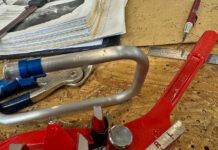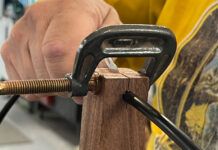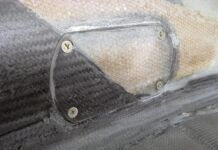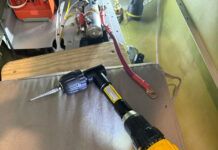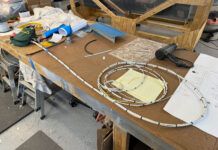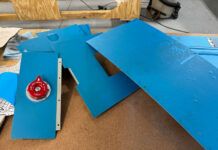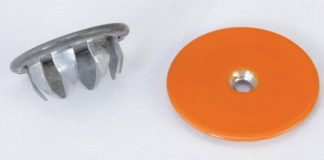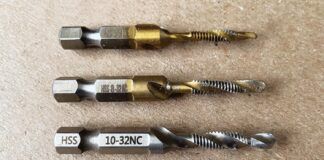A year ago, when we began this series, my marching orders were simple: “The Home Machinist” should be for the beginner and the guy who’s always wanted a lathe and mill, but just didn’t know where to begin. In the past year Ive heard from many of you asking, “Should I buy X?” or saying, “I always wanted to do this sort of thing. Thanks for the encouragement.” KISS-keep it simple, stupid-seems to be a working formula.
I have three subjects for you on this one-year anniversary. One is simple and doesn’t need an entire column. The second takes a book-maybe several. The third is a reader-suggested cool tool. While that second one may seem to violate the KISS principle, hang in there, and I think you’ll find that its simple in the initial application but with an amazing potential for elaboration.
The Steady Rest
Last month we spoke of the traveling rest. You’ll recall that its function is to support a long, skinny, flexible shaft so that we could make a controlled diameter cut anywhere along its length.
This month we’ll meet its cousin, the steady rest. By that sobriquet, you’ll deduce that where the traveling rest moves, the steady rest does not. As for its purpose, a look at the setup should give you a clue. Where the traveling rest was for slender material, the steady rest is for most any material thats extended perilously beyond the chuck. Without it the material could be off across the shop faster than the Caped Crusader when the Bat Signal is lit.
Setting it up is straightforward. The traveling rest has two bronze points to resist the pressure of the cutting tool. The steady rest, however, has three points, and it will also hold the material against the pressure of cutting. But its job is to support an overextended mass that is frequently straight from the supply rack, so if your material is scored or dented you might need to sand it lightly to get smooth rotation. You’ll definitely want to add a bit of axle grease to the points as well.
To get it turning true, you’ll have to loosen the points and then, with a dial indicator on the end closest to the steady rest, rotate the material by hand. The chuck should be firm but not tight as you check for runout.
Assume you have a total of 0.020 inch movement of the dial indicator. You’ll need to then rotate the material so that the dial indicator reads maximum upward deflection, and then loosen the two lower points. Now turn the adjustment of the upper point on the steady rest to bring it back up one half of that distance. Complete the tune-up by turning the other two points in until they barely touch the material and rotate the material, again by hand, another 720 to verify you zeroed the runout.
Tighten the jaws of the vise and don’t forget the lock-screws on the steady-rest points. Check that all is clear, remove the dial indicator and start your cuts. Its a simple tool, but vital if you were, say, cutting an annular O-ring groove on a long shaft that would not fit in the lathe any other way.
Google SketchUp
If all you’re going to do is drill a single hole, just grab the layout fluid, a scribe to mark a couple of lines, and go for it. But what if you have a project with a couple of holes and several surfaces that need machining, and you’re not sure of position and size? Winging it can be a fast track to understanding the reply that machinists have to the question: “Whatcha making?” “Chips.”
Lets start with a clarification: CAD is an acronym for computer-aided design. AutoCad is a product name, as are SolidWorks, IronWorks and others. Before I get too far into this narrative Id like to quote my wife: “This is fun! Ive now done it enough that it goes faster to do it with CAD than the old way.” She’s doing landscape design, but the principles are the same. You don’t have to be an engineer or computer geek devoting mega-hours to learn such programs.
Anywhere from $500 to $5000 for a CAD program is a bit stiff for the home machinist. So how about a program with the all the functions you need, but it’s free? Thats right, free. It’s not a demo that will cease to work in 30 days or a program that prevents you from saving or printing your work, either. It’s Google SketchUp.
Right here I should quote Google: “SketchUp is not the same as Computer Assisted Design or CAD.” With perhaps false modesty, SketchUp is described as a program for examining design concepts, while CAD is able to represent concrete information. (Hey, Im designing and the computer is assisting. If it walks like a duck and quacks like a duck…)
For us, there are two significant but immaterial differences between what Google defines as CAD and SketchUp. First, SketchUp does not allow you to translate your model into a drawing that includes all the views on a single page and then add date, revision number, part number, etc. But for our home machinist, thats not a problem
The second distinction centers on the use of the word “concrete.” Said
distinction becomes clear when you do a cross-section view of your model. With high-end programs such as Inventor and SolidWorks you would see a solid interior; it would look exactly as if you had sliced through the real thing. With SketchUp you see only the outer walls. Should you wish to remove the interior, those high-end programs allow you “shell” it, but with SketchUp every cylinder is a soup can that has walls, but with an undefined thickness.
I’ll not go in to the difficulties of programming here. Ill only point out that with a solid I can assign characteristics such as density and stiffness. The program then calculates the volume and will tell me instantly such things as mass and center of gravity, and it will even pinpoint stress concentrations. When I put together an assembly of solid parts the big-bucks programs will tell me those same characteristics for the finished machine.
SketchUp is not going to deliver that level of sophistication. Its, well, a sketch, albeit a sophisticated one. If all you want to do is develop an idea of what a part should look like and where to drill a couple of holes, SketchUp is for you-especially at the price.
Before you begin, you need to be clear on a bit of terminology: Drawings are two-dimensional; they are what you are accustomed to doing with a pencil and what you print out on paper. Models, on the other hand, can be flipped or turned to see the other side just as you would if they were the real thing. What you’ll create with SketchUp is not a drawing; its a model that you can dimension and then print.
I prefer to end on a positive note, so first I’ll register one large complaint. If the directions in the Help files say to activate a command, such as “copy,” the copy icon should show, not simply say that the user should “click on the copy icon.” If I knew what the copy icon looked like, I wouldn’t be requesting help! This is a classic extension of, “How can I look up a word if I don’t know how to spell it?”
Now the good. Directions should be stated in the order to be carried out. SketchUps do; the directions are one, two, three. The introductory tutorial is one of the best Ive ever seen. Its fast-paced and straightforward, yielding quick results that only encourage the student to want more.
I have two fairly minor complaints about this otherwise excellent tutorial. First, when extending a face with the push/pull tool, the instructions say to click on the area to be extended, and then click on the face that you want to use as the termination. Thats not right; you hold down the left button to start the pull, move the cursor over the terminating face and then release. Try it in Lesson 2, Step 5 to see what I mean.
The second “oops” is that Lesson 3, Step 13 says to go to the Windows pull-down menu and click on the non-existing option, “Display Settings,” when it should be “Styles.” Its a minor point but worth the rummaging around to find the command.
Something I did not find in the
lessons, but worth knowing from the outset, is that a wheel mouse is perfect for this program. That middle button/wheel allows you to zoom in or out quickly. The trick is to place the cursor over the position that you want be the center of the zoom. Neglect to do this and the model goes sailing out of view.
Another great aid is the Quick Reference Card. Be sure to print it out and keep it handy as you’re learning.
You might also notice that when drawing a rectangle you’ll see a little
window that flips between square, golden rectangle and blank. That second one is an interesting bit of mathematical non-trivia that has to do with the ratio of the length and width of a rectangle. Rather than give an extended discourse on the subject, Ill invite you to go to www.mathopenref.com/rectanglegolden.html to see an interesting treatise and some nice interactive graphics. You’ll be able to amaze your kids with a bit of esoterica. More likely you’ll confirm that Dads a geek, but I liked it.
Customization is both easy and necessary if you’re going to really rip with this program. Go to Views > Tools and activate a few of them. I prefer to work in decimal inches instead of feet and inches, and though snap increments of inch are handy in some circumstances, they make it impossible to have a material with a thickness of, say, 0.090 inch. Turn that off and you’ll find smaller components a lot easier to draw.
With time, you’ll discover both what you use and what you don’t. Rummaging around in the Tools bag is also handy, as you’ll find ways to do things that you would not have guessed.
Really, that is the key to learning this type of modeling. You have to pretty much set aside the tricks and procedures you’ve learned with an HD pencil, straightedge and protractor. An example of this would be to draw a 0.500-inch circle whose center point is, say, 2.25 inches away from the midpoint of a given edge. Paper drawing would have you measure to find the midpoint of the edge, or even do a construction with a compass to find it, then a perpendicular line out to 2.25 inch, then a compass set at 0.25 inch radius. You finish off by erasing all that construction work.
In SketchUp, you select the line icon, put the cursor on the edge and automatically find the midpoint, then move out on an automatically derived perpendicular line to where you want the center of the circle and click. Next select the circle icon and place the cursor on the end of that line you drew. Enter the radius of the circle and click. Now select the eraser icon and click once to send that first line you drew into computer limbo. Different CAD programs do it differently, and Im sure there’s a reader out there who will write to tell me of a better method. That brings up another advantage: There is a large and talkative body of users out there who can help or with whom you can share techniques and models.
A nice feature of this program is the ability to rough-out the object and then fine-tune it by pulling or pushing edges of features. For instance, I drew an instrument panel by first making a rectangle of about the right size and then “pulled” the face of it to get the material thickness. I then added dimensions and found that it was too long, so I simply selected one of the faces and pulled it back until I got the right size. For instance, if it had been 44.160 inches wide and I wanted 44 inches exactly, I could also simply type in 0.160 inch, select the face thats to be moved, and hit enter. Presto, exactly 44 inches.
Holes cut for radios or other instruments are equally easy: Place them, replace them, copy them, move them or resize them. Were this paper, youd have worn a hole through it with your Pink Pearl eraser.
Here comes the caveat: You’ll have to practice. The similarities to driving a car could encourage you to take an aircraft control yoke in hand, but landing successfully will take lessons, patience and practice. And, as with flying, you’ll be amazed how quickly you get to the point of soloing. The sense of accomplishment when you’re finally proficient is similar as well. One nice difference, though, is that the $100 hamburger is not required in CAD.
Does it work? Well, I downloaded the program, installed it, ran through the lessons, wrote half this article, made a drawing of a component I want to build for my airplane, dimensioned it, and printed it out in 4 hours. For the home machinist, thats as good as it gets.
Ive been using CAD for about 15 years, with my current software worth about $5000. For what is needed by the home machinist, this program compares favorably in performance to the high-end stuff, which is nothing short of amazing in that the program is free. Download it at http://sketchup.google.com and take the time to learn it.
Cool Tool
Reader Jack Dalton wrote to suggest that anyone with a lathe needs a scraper/file/chip grabber/scribe. The tool truck probably doesn’t have one but you can make it yourself. Its nothing more than a three-corner file with a couple of inches of the teeth ground off and the remainder mounted solidly in a handle. Jacks correct: Ive been using one since 1973, and it does come in awfully handy.
Keep a big jug of water handy when you’re grinding the teeth down. File-quality steel defines “hard,” and you don’t want to lose that advantage by inadvertently annealing that hardness right out of it.
You can use the curvature of your grinding wheel to your advantage by moving the file smoothly over the face of the wheel, but don’t rotate the file or move it off the tool rest. This will give you three edges, each with an almost knife-like sharpness due to the concave surfaces generated by the diameter of the grinding wheel.
That wraps up this first-anniversary column, and I look forward to a few more. If you’ve an idea for a tool, a suggestion, or a process you’d like to see, let us know. If I know how, have or can get the proper equipment, and it’s not too terribly advanced, ‘Ill give it shot.
Editors note: If you have specific questions for author Bob Fritz, or if you have certain projects you’d like us to cover, email us at [email protected] with “Home Machinist” in the subject line.

